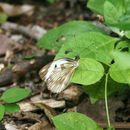en
names in breadcrumbs


Pieriballia is a genus of butterflies in the family Pieridae erected by Alexander Barrett Klots in 1933. Its only species, Pieriballia viardi, the painted white or viardi white, was first described by Jean Baptiste Boisduval in 1836. It is found from Mexico to Bolivia and Paraguay.[2] Strays can be found in southern Texas in the United States.[3] The habitat consists of rainforests and transitional cloud forests.[2]
The wingspan is about 57 mm (2.2 in).
The larvae feed on Capparis pseudocacao.
The following subspecies are recognised:[1]
Pieriballia is a genus of butterflies in the family Pieridae erected by Alexander Barrett Klots in 1933. Its only species, Pieriballia viardi, the painted white or viardi white, was first described by Jean Baptiste Boisduval in 1836. It is found from Mexico to Bolivia and Paraguay. Strays can be found in southern Texas in the United States. The habitat consists of rainforests and transitional cloud forests.
The wingspan is about 57 mm (2.2 in).
The larvae feed on Capparis pseudocacao.